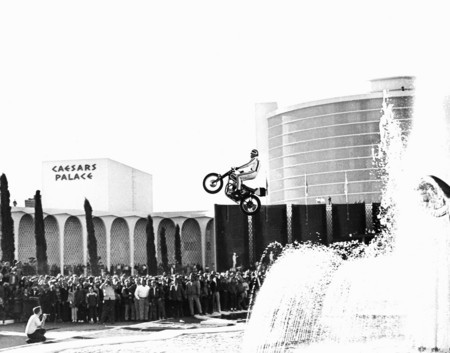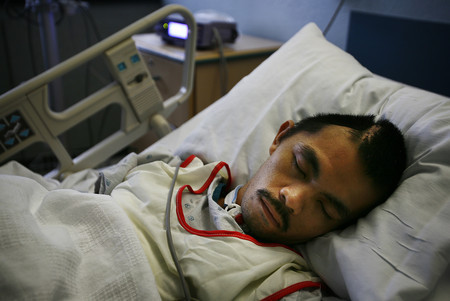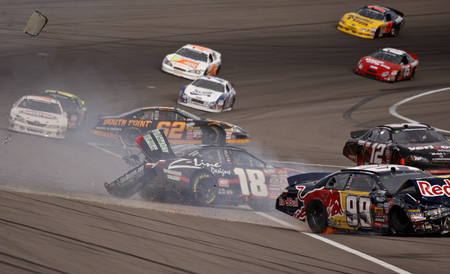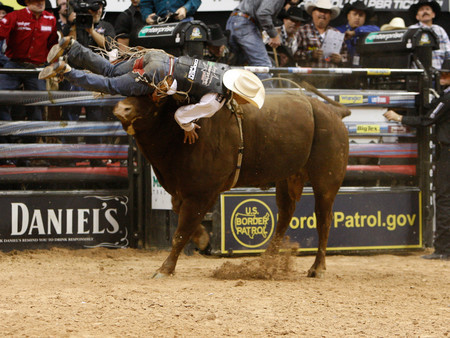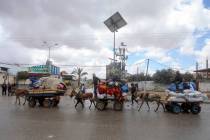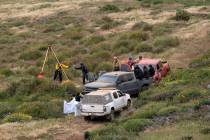Medical insurance coverage an issue for Las Vegas events
First, the good news: Surgeons at University Medical Center have successfully reattached the piece of skull that had been removed from bantamweight boxer Z "The Dream" Gorres, who suffered a traumatic brain injury after a November fight at Mandalay Bay's House of Blues.
Now the bad news: Last week's intricate procedure at the publicly funded hospital, combined with more than two months of around-the-clock nursing care and painstaking rehabilitation work by a team of physical therapists, has driven the medical expenses of the financially strapped Gorres to nearly $600,000. It's a bill that Southern Nevada taxpayers must largely pick up, because state law requires promoters to put up only $50,000 worth of medical insurance for each fighter in the ring.
The consequences of the Filipino boxer's brain injury have prompted elected officials and the Nevada Athletic Commission to work toward crafting a solution that keeps taxpayers off the hook for the medical care of professional boxers.
But Las Vegas is home to lots of different events, and some are very risky. Could Clark County taxpayers end up footing the bill when other athletes or entertainers are hurt when performing here?
"We probably have more big events than any other city in the country," said Dr. Dale Carrison, head of the emergency department at UMC and its chief of staff. "As everyone knows, Las Vegas is a magnet for that sort of thing. And if someone does get badly hurt, UMC's trauma center generally takes care of them."
NASCAR, National Finals Rodeo, Cirque du Soleil, daredevil stunts by the likes of the late Evel Knievel, the Las Vegas Rock 'n' Roll Marathon, National Hot Rod Association drag racing, championship boxing and mixed martial arts -- these are just some of the major events held in Las Vegas.
A survey of medical insurance coverage held by individuals who engage in events or performances where there is risk of injury -- the kind of events that thrill both live and TV audiences -- has found that coverage can range from nothing to 100 percent.
Bill Rundle, a longtime promoter of Knievel, said last week that the motorcycle daredevil "who broke every bone in his body" generally couldn't get medical insurance for his stunts because "they were too dangerous."
"No one would write him a policy for something where there was a good chance he wouldn't make it. It's that way with most people who do those kind of things."
Rundle also has promoted some stunts performed by Knievel's son, Robbie, "and getting insurance was always a problem for him, too."
Robert Zirkelbach, a spokesman for America's Health Insurance Plans, a trade association for 1,300 companies, said it would not be uncommon for an insurance company to refuse to cover a daredevil, or to offer medical coverage at such a high premium that it would be difficult to afford.
Attempts to reach contemporary daredevil Robbie Maddison, whose successful motorcycle jump at the Arc de Triomphe at Paris Las Vegas wowed crowds on New Year's Eve 2009, were unsuccessful. Maddison has suffered a number of serious injuries in stunts around the world.
Both Rundle and Zirkelbach said community leaders should be aware of the possible financial consequences should a daredevil be injured during a stunt in their community.
It was a 1967 stunt at Caesars Palace, Rundle said, that helped cement Evel Knievel's reputation as a performer who would risk his life to entertain an audience. When Knievel attempted to clear the casino's fountains on his bike, he took a nosedive that landed him in Southern Nevada Memorial Hospital -- later named UMC -- for several weeks with multiple pelvic fractures.
"That was early in his career, and he didn't have money to pay his medical bill," said Rundle, who talked on the phone from the Mayo Clinic in Arizona where he is being treated for cancer. "I think there were a lot of medical bills he walked away from until he was making good money. Then he had enough to pay them out of his pocket."
In 1974, the city manager in Carson City said police would arrest Knievel if he reappeared in the state because he didn't pay a hospital bill there that he incurred in 1968. Knievel ended up in a Reno hospital for 22 days after he unsuccessfully attempted to jump 16 automobiles on his motorcycle.
A collection agency representing Southern Nevada Memorial finally caught up with Knievel in the 1970s, the decade when he netted more than $6 million for his failed Snake River Canyon jump.
The Review-Journal reported that Knievel had "rolled up" a bill of $2,249.51 for his 1967 hospital stay in Las Vegas.
"The cost of medicine has gone up over the years," UMC's Carrison said.
EVOLUTION OF INSURANCE
Although daredevils have a difficult time getting insurance, NASCAR drivers don't.
Jim Hunter, spokesman for the stock car motor racing giant that has a race scheduled in Las Vegas next month, said each driver and crew member now has a medical insurance policy of slightly more than $1 million.
"Even that may not be enough if something really terrible happens," Hunter said in a phone call Thursday from Daytona Beach, Fla.
In 60 years, Hunter said, medical coverage has grown from $2,000 to its present $1,000,050.
"As the sport grew, there was more at stake," said the 70-year-old Hunter, who is currently undergoing treatment for lung cancer. "At first, guys were racing as a hobby. They weren't making a living out of it."
Hunter said the 2001 death of driver Dale Earnhardt at the Daytona Speedway energized safety efforts by NASCAR, including collision absorbing walls and new head and neck restraints for drivers.
"But no matter what we do, accidents can and will happen and our medical insurance reflects that," he said.
Like NASCAR, medical insurance for participants in the National Finals Rodeo has dramatically increased over the years.
Jerry Ford, who has written coverage for the Professional Rodeo Cowboys Association for decades, notes that the present coverage of $250,000 is a huge jump from "where we started years ago."
"When we first started in the '70s, the maximum limit was $3,000," Ford said. "It wasn't until the late '90s that we got limits above $20,000."
Since that time, he said, there have been only 10 or 12 performers who "maxxed out" their medical coverage.
One rodeo performer who Ford is certain did that in Las Vegas was bull rider Tuff Hedeman in 1995. Participating in the Professional Bull Riders World Championship finals, Hedeman was bucked off by the bull Bodacious and suffered severe facial injuries.
"I was the first doctor there," Carrison said. "It was awful. He ended up needing 11 plates in his face."
Hedeman stayed only a few days in the hospital after his plastic surgery.
"There was never any question about his paying the bill," Carrison said. "I'm sure I would have heard about it."
Both Carrison and Ford said rodeo participants hold fundraising rodeos to pay off such bills.
Don Andrews, who was part of the Justin Sports Medical team at rodeos for years, said, "PRCA cowboys don't walk away from bills. They get together and pay them off."
Ford said he would not be surprised if bull riders suffer catastrophic brain injuries similar to a boxer's. "Unfortunately, head injuries happen frequently."
The most tragic bull riding incident in Las Vegas occurred in December 1994 when rider Brent Thurman was bucked off a bull. The huge animal, Red Wolf, stepped on the back of his neck.
Thurman suffered facial and cranial fractures and massive internal bleeding. He was treated at UMC. Like Gorres, the boxer at the hospital now, Thurman's brain swelled. After spending six days in a coma, the 25-year-old Thurman died.
PAYING THE PRICE
Many boxers have seen their careers end in Las Vegas.
From 1995 to 2005, 10 fighters sustained career-ending brain injuries in Nevada, with two boxers, Leavander Johnson and Martin Sanchez Jr. both dying from subdural hematomas, the same brain injury Gorres sustained.
Because of federal privacy laws, UMC officials are unable to release the medical records of fighters, athletes or entertainers to whom they gave care. Gorres' wife gave UMC permission to release her husband's medical information to the Review-Journal. He was released from the hospital last week and is staying with friends in Las Vegas while undergoing rehabilitation.
Despite the lack of such information, UMC officials said Gorres' case is an indication that UMC has not been reimbursed for care that could reach into the millions of dollars.
While thousand of people each year are mesmerized by the beauty and grace of the Cirque du Soleil shows in Las Vegas, there's no doubt the acrobatic performers engage in risky maneuvers.
Audience members watched in horror in 2007 when two performers fell from as high as 35 feet during a "Zumanity" show at New York-New York. Both hit the stage; one performer was left in critical condition. Both were treated at UMC.
But the cost for medical care for Cirque performers, according to show spokeswoman Ceres Hill, is fully covered by the organization's insurance plan.
The thousands of participants in the Las Vegas Rock 'n' Roll Marathon basically fend for themselves when it comes to health insurance, spokeswoman Lee Haney said.
Last year, Eric Reitman, a Las Vegas resident who collapsed near the end of the half marathon, died.
Less serious health problems are common, Haney said.
"Whenever you have more than 20,000 people involved in an event, you're going to have some injury," she said.
Marathon participants often buy a personal insurance policy through USA Track & Field, Haney said. Though repeated phone calls to the organization were not returned, its Web site said individuals can purchase a policy that has a maximum accidental bodily injury payout of $10,000.
Just how much, if any, medical coverage is carried by drag racers competing in the National Hot Rod Association events seen frequently at the Las Vegas Motor Speedway is unknown.
"That's not something we want to divulge," association spokesman Anthony Vestal said.
Community leaders should make sure they know how much medical insurance coverage is carried by performers in risky events, Carrison said.
Not taking action when coverage seems insufficient can be costly, he said.
"We're seeing that right now with what happened to that poor boxer."
Contact reporter Paul Harasim at pharasim@reviewjournal.com or 702-387-2908.



